Body Recomposition at Home: Lose Fat & Gain Muscle (No Gym)
I’ve been working out for months, but the scale won’t budge. Am I doing something wrong?
You’re not alone. Thousands of people just like you are stuck in the frustrating loop of dieting and exercising without seeing real results. You want to look leaner, feel stronger and build a body that turns heads, but you don’t have time or money for a gym membership.
Here’s the good news: you can lose fat and gain muscle at home, a process called body Recomposition and you don’t need fancy equipment or a personal trainer to make it happen.
Let’s break down exactly how to achieve body recomposition from your living room, with science-backed strategies, real-world tips and zero fluff.
Also read – Realistic Fitness Goals for College Students
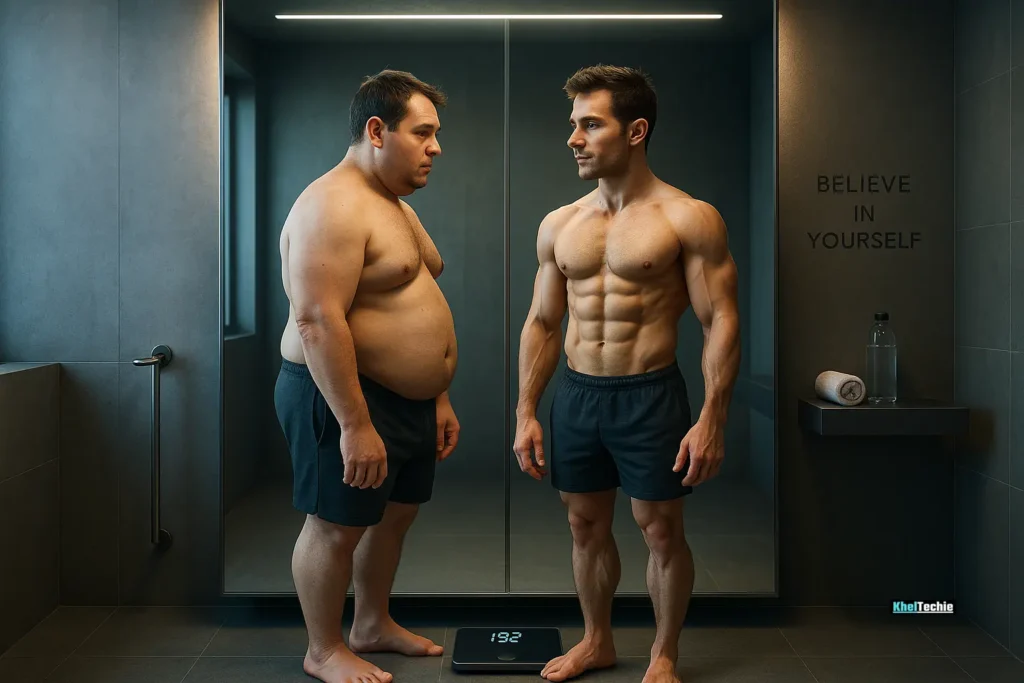
What is Body Recomposition?
Imagine this, instead of just losing weight on the scale, you’re actually replacing flab with lean muscle. That’s body recomposition, a simultaneous shift where fat goes down, muscle goes up and your body transforms even if the number on the scale barely changes.
It’s like upgrading your phone’s internal hardware while keeping the same case. Externally, it looks similar but inside? Faster, stronger & more powerful.
Unlike traditional weight loss (which often burns muscle along with fat), body recomposition focuses on fat loss + muscle gain at the same time. And yes, you can do this at home.
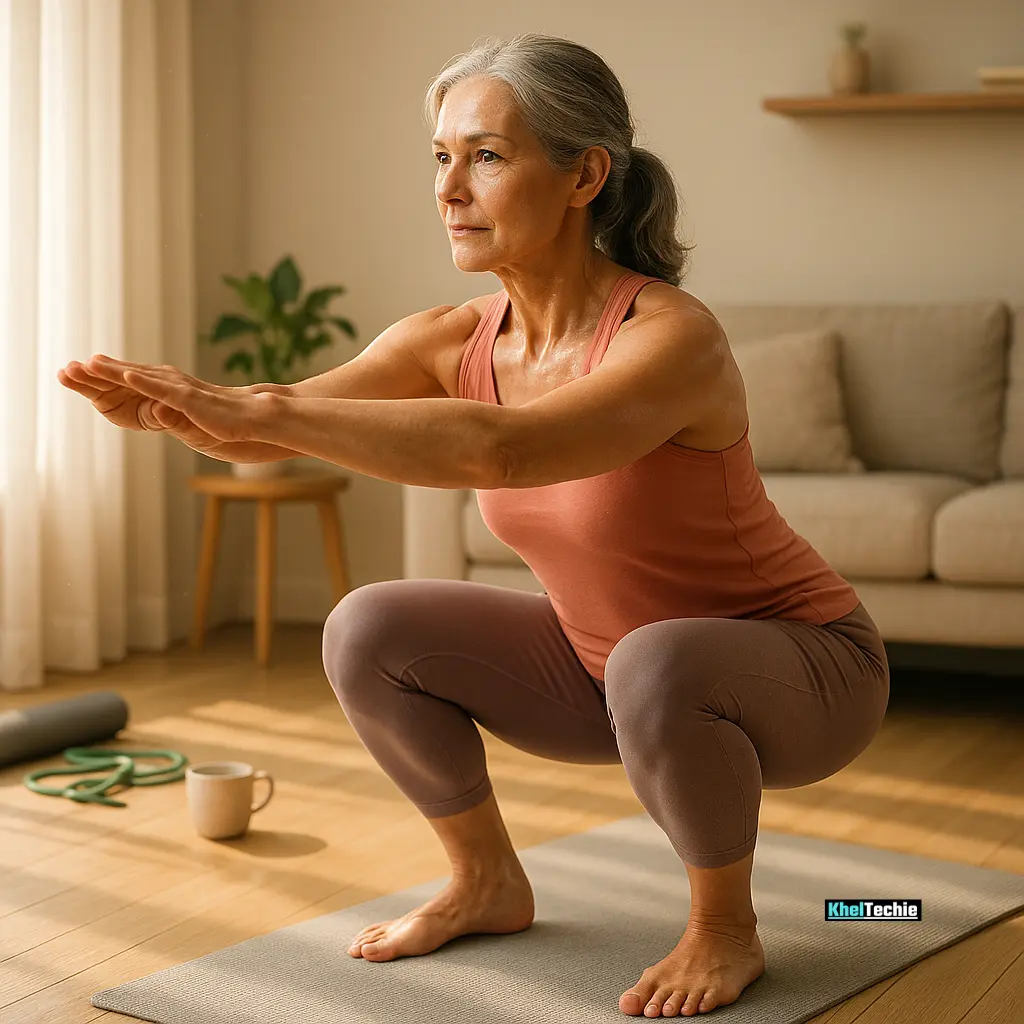
Why Body Recomposition Matters (Especially at Home)
Trying to lose fat and build muscle from home might sound too good to be true but the latest science proves it’s absolutely possible.
According to a new 2024 study from MDPI, even women in their 50s saw amazing changes by doing simple workouts at home. They combined strength-based moves like squats and push-ups with light cardio. Within just 8 weeks, they started gaining lean muscle and by week 12, they had lost noticeable fat, without their weight changing much at all. That’s the magic of body recomposition: your weight might stay the same, but your shape, strength and health improve big time.
And here’s where nutrition takes the spotlight.
According to a recent review on ArXiv, having 20–25g of protein right after your workout and again before bed can supercharge your results. This habit helps your body recover faster and build lean muscle more efficiently, even as you lose fat. For people training at home, this is a total game-changer. You don’t need fancy shakes either – eggs, Greek yogurt or a quick protein bar do the trick.
Bottom line? You don’t need a gym or fancy equipment to see a serious transformation. With the right training plan and smart protein timing, you can reshape your body right at home. It’s sustainable, effective and backed by the latest science. Focus less on what the scale says and more on how you feel, look and move.
This isn’t a trend, it’s a lifestyle shift. And it works.
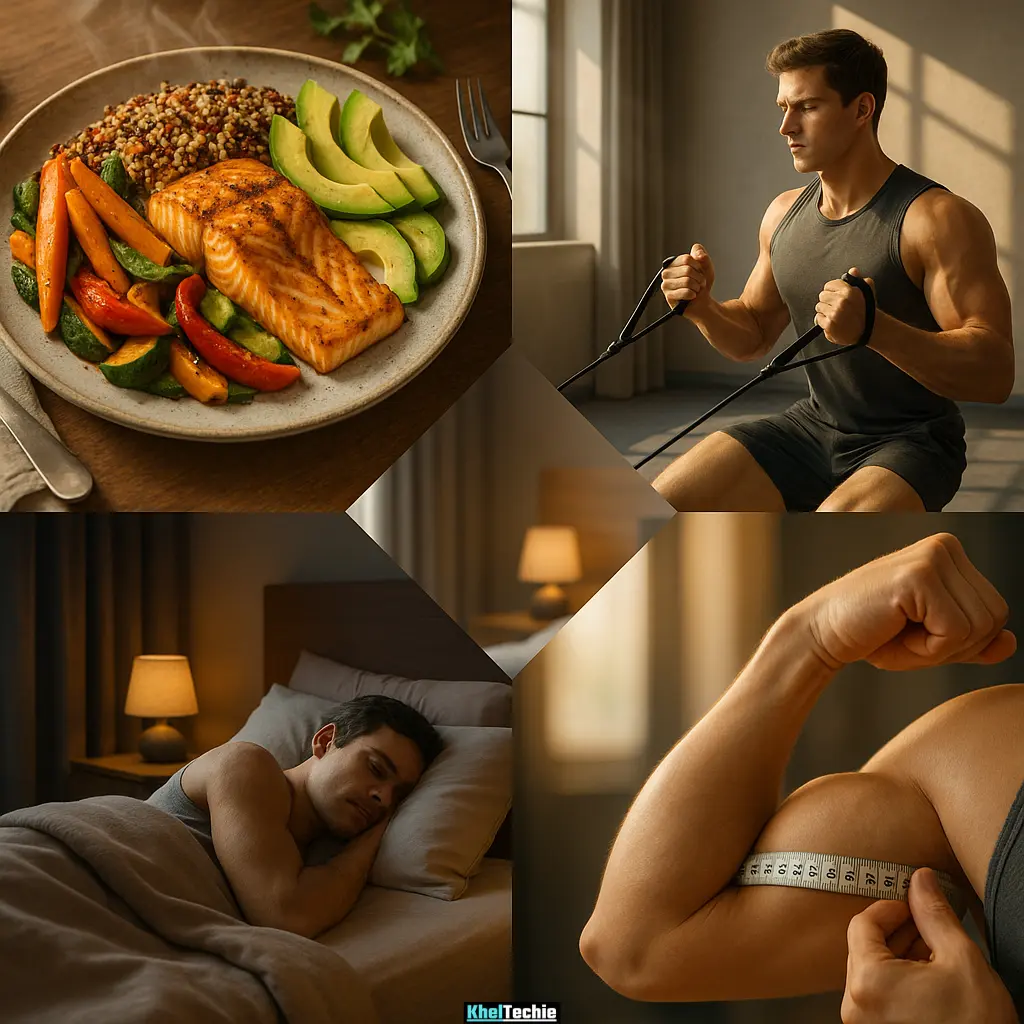
Step-by-Step Guide: How to Lose Fat and Gain Muscle at Home
Let’s walk through the exact process — step by step — so you can start today, even if you’ve never lifted a dumbbell.
Step 1: Master Your Nutrition
You can’t out-train a bad diet. For body recomposition, nutrition is 70% of the battle, but this isn’t about starving yourself or counting every calorie. It’s about smart fueling.
a) Eat Enough Protein
Muscle is made of protein. If you don’t eat enough, your body can’t build it, no matter how hard you train.
Target: 0.8–1.2 grams of protein per pound of body weight daily.
For a 150-pound person: 120–180g of protein/day.
Best at-home protein sources:
- Eggs
- Greek yogurt
- Canned tuna or chicken
- Cottage cheese
- Lentils and beans
- Protein powder (whey or plant-based)
Spread protein across 3–4 meals. Your body can only use ~30g per meal for muscle synthesis
b) Control Calories But Don’t Obsess
To lose fat, you need a slight calorie deficit. But too big a deficit kills muscle growth.
Ideal approach: Eat at maintenance or a 10–15% deficit.
Use this quick formula:
- Multiply your weight (lbs) by 14–16 → daily maintenance calories.
- Subtract 10–15% → your target.
Example: 150 lbs × 15 = 2,250 cal → minus 15% = ~1,900 cal/day.
Track for 1–2 weeks using free apps like MyFitnessPal or Cronometer, then adjust based on progress.
c) Prioritize Whole Foods
Avoid processed junk, Focus on:
- Vegetables (spinach, broccoli, peppers)
- Fruits (berries, apples, bananas)
- Whole grains (oats, brown rice, quinoa)
- Healthy fats (avocado, nuts, olive oil)
Meal prep on Sundays. Cook big batches of grilled chicken, rice and roasted veggies & Portion into containers. Boom, healthy meals all week.
Step 2: Build Muscle with Smart At-Home Workouts
You don’t need a gym. You need progressive overload, gradually increasing the challenge to your muscles.
Here’s how to do it at home:
a) Use These Tools (All Under $50)
- Resistance bands ($15–$30)
- Adjustable dumbbells or water jugs (DIY weights)
- Pull-up bar (doorway mount, $25)
- Yoga mat ($10)
b) Follow a 4-Day Strength Plan (Beginner to Intermediate)
| Day | Focus | Sample Exercises |
|---|---|---|
| Monday | Upper Body | Push-ups, band rows, shoulder press |
| Tuesday | Lower Body | Bodyweight squats, lunges, glute bridges |
| Thursday | Upper Body | Pull-ups (or band-assisted), chest press, bicep curls |
| Saturday | Lower Body + Core | Step-ups, wall sits, planks, leg raises |
Workout Structure:
- 3 sets of 8–12 reps per exercise
- Rest 60 sec between sets
- Increase reps or resistance weekly
Progressive Overload Hack: Add 1 rep per set each week Or switch to a thicker resistance band.
c) Sample Home Workout (No Equipment)
Upper Body Blast (15 mins):
- Push-ups – 3 × 10
- Incline push-ups (hands on couch) – 3 × 12
- Superman holds – 3 × 20 sec
- Plank to shoulder taps – 3 × 10 per side
Lower Body Burner (15 mins):
- Air squats – 3 × 15
- Walking lunges – 3 × 10 per leg
- Glute bridges – 3 × 15
- Calf raises – 3 × 20
Do this 4x/week. Add 10 lbs of resistance (backpack with books?) every 2 weeks.
Step 3: Optimize Recovery (Where Growth Happens)
Muscles don’t grow during workouts, they grow when you rest.
a) Sleep Like It’s Your Job
Aim for 7–9 hours/night. Poor sleep increases cortisol (fat-storing hormone) and reduces testosterone (muscle-building hormone).
Fix your sleep:
- No screens 1 hour before bed
- Keep room cool and dark
- Try magnesium or chamomile tea
b) Manage Stress
Chronic stress = high cortisol = belly fat storage and muscle breakdown.
Try:
- 5-minute breathing exercises
- Daily walks
- Journaling
c) Stay Hydrated
Dehydration reduces strength and endurance. Aim for half your body weight (lbs) in ounces of water daily.
Example: 150 lbs → 75 oz (~9 cups)
Step 4: Track Progress the Right Way
The scale lies. Body recomposition often means the number stays the same but you look and feel completely different.
Use These 4 Tracking Methods:
- Progress Photos – Take front/side/back pics every 2 weeks in the same lighting.
- Measurements – Tape measure your chest, arms, waist, hips, thighs.
- Clothing Fit – Are jeans looser? Shirts tighter on arms?
- Strength Gains – Can you do more push-ups? Heavier bands?
Don’t weigh yourself daily. Weigh once a week, same time, same clothes.
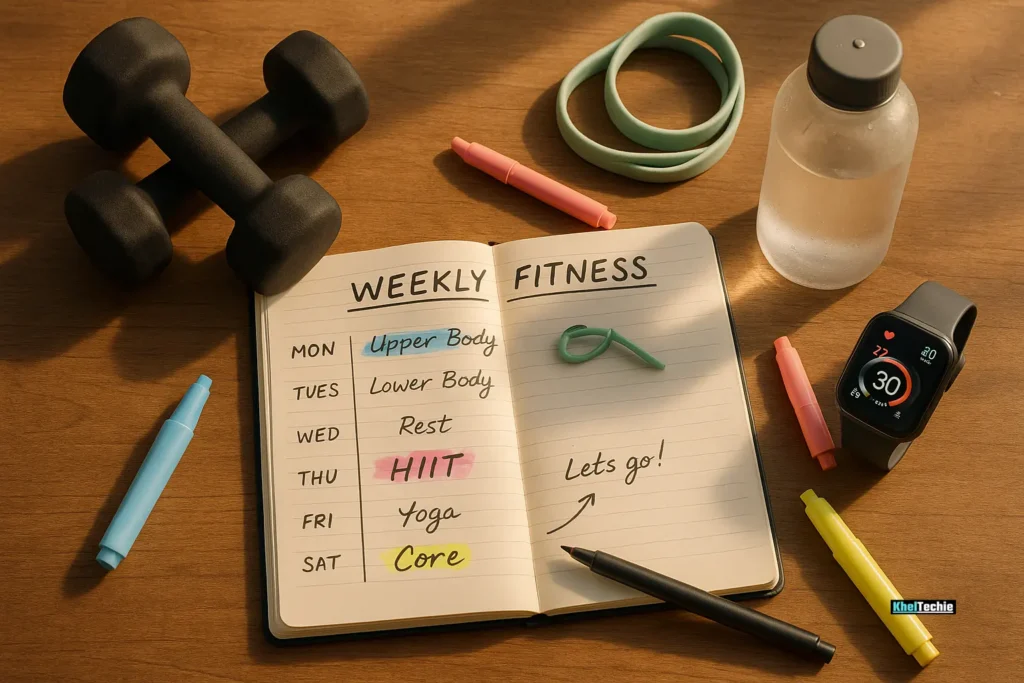
Weekly Home Workout Breakdown Plan
| Day | Focus | Example sessions |
|---|---|---|
| Mon | Full‑body strength | Goblet squats, push-ups, rows, lunges supersets |
| Tue | HIIT & Core | Burpees, high knees, planks, Russian twists |
| Wed | Lower body focus | Glute bridges, step-ups, dead bugs |
| Thu | Rest or mobility/yoga | Light recoveries: dynamic stretches, walking |
| Fri | Upper‑body strength | Dumbbell rows, shoulder press, tricep dips, push-ups |
| Sat | HIIT or metabolic resistance | Circuit with dumbbells or bodyweight, 25 sec work /15 sec rest format as seen on Juice & Toya video |
| Sun | Rest | Reflect, hydrate, stretch |
Switch workouts monthly to avoid plateaus. Increase resistance or reps gradually and customise the above plan according to your flexibility and availability.
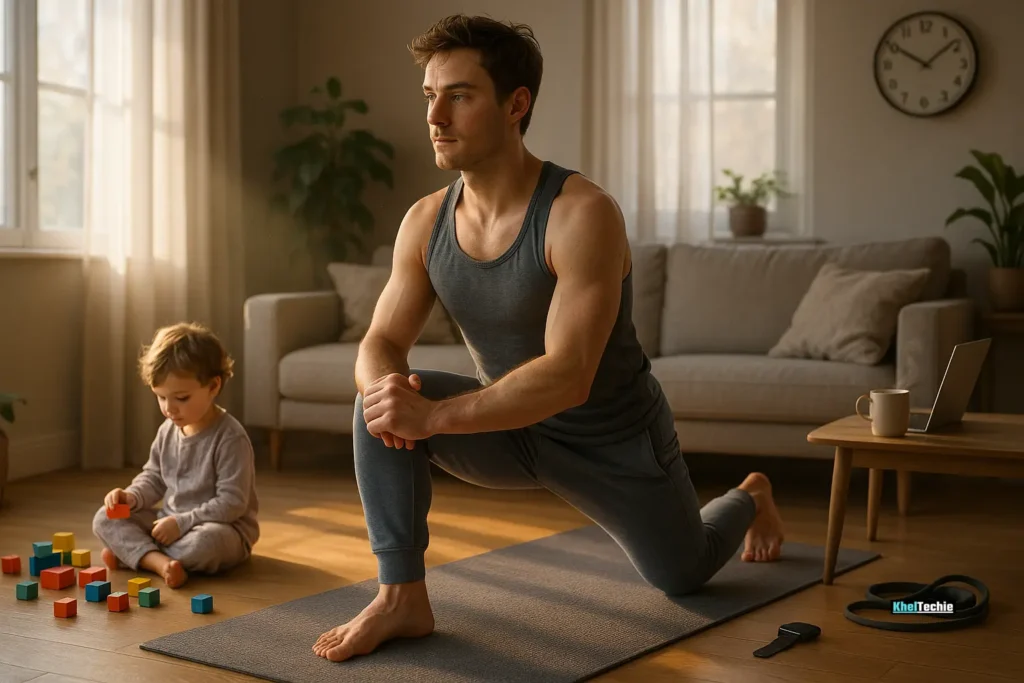
The Truth About “No Time” And How to Fix It
“I don’t have time” is the #1 excuse.
But here’s the truth: You don’t need hours.
- 20 minutes of strength training, 3x/week = results
- 10-minute walk after meals = better fat loss
- 5 minutes of stretching = better recovery
Try this:
Next time you’re scrolling Instagram, do 10 push-ups instead. Then 10 squats. That’s a micro-workout. Do 3 a day? That’s 90 reps, no gym needed. Small efforts compound
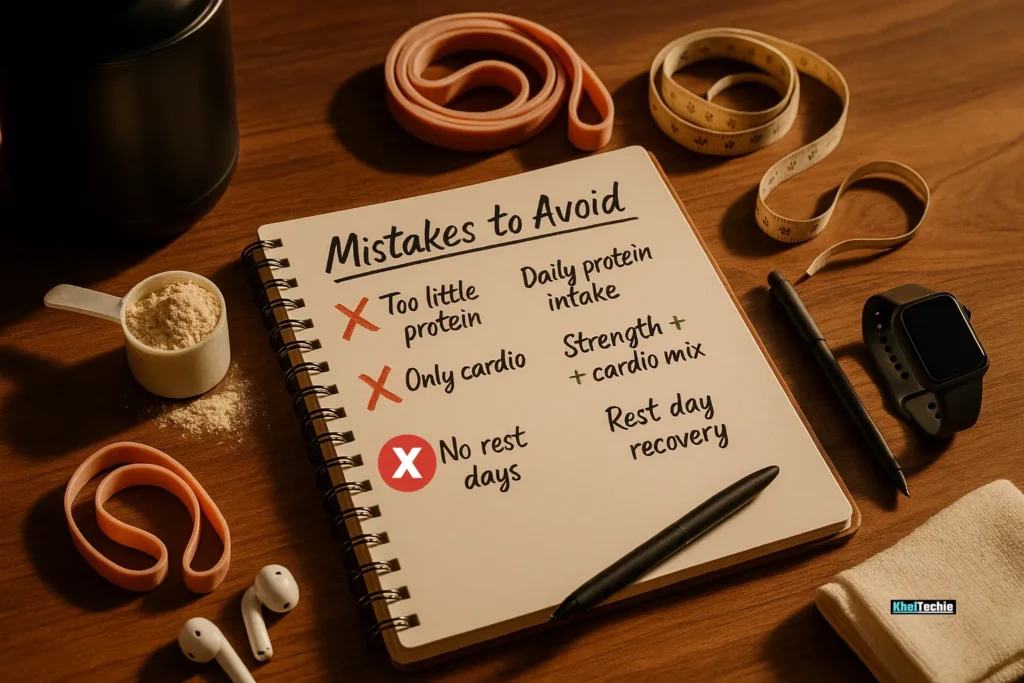
Common Mistakes to Avoid And How to Fix Them
Even smart people mess this up. Here are the top 5 errors and how to dodge them.
1. Eating Too Little Protein
Mistake: Thinking “low-calorie = faster fat loss.”
Result: You lose muscle along with fat. You look “skinny fat.”
Fix: Hit your protein target first, then adjust calories.
2. Doing Only Cardio
Mistake: Jumping on the treadmill daily, skipping strength work.
Result: You burn calories but don’t build muscle. Metabolism slows.
Fix: Strength training 3x/week. Add short cardio bursts (like 10-minute jump rope).
3. Ignoring Progressive Overload
Mistake: Doing the same 10 push-ups every day for 3 months.
Result: Plateau city.
Fix: Each week, try to:
- Add 1–2 reps
- Slow the tempo
- Add resistance
Track it in a notebook or app.
4. Expecting Fast Results
Mistake: Giving up after 2 weeks because “nothing’s happening.”
Reality: Body recomposition takes 8–12 weeks to show visible changes.
Fix: Focus on daily habits, not weekly results. Trust the process.
5. Skipping Rest Days
Mistake: “More is better” mentality.
Result: Burnout, injury, stalled progress.
Fix: Schedule rest like it’s a meeting. Your body needs it to grow.
Also read – How to Restart Your Fitness Journey After a Setback

Final Thoughts: Your Body, Your Rules
By now, you’ve got the blueprint: definition, nutrition, training, recovery and smart tracking. You can absolutely lose fat and gain muscle at home & You don’t need a membership, You don’t need perfect genetics, You don’t need 2 hours a day.
You just need:
- Protein to build muscle
- Resistance to challenge your body
- Consistency to see results
And most of all patience. Body recomposition isn’t a 30-day challenge. It’s a lifestyle shift and the best part? You’re already at the starting line. Your living room, Your kitchen, Your backyard, That’s where transformation begins. Start with doable routines and a slight dietary tweak, stay consistent, and be kind to your body and mind. Results might be gradual, but they’re real and sustainable & You can do this at home, on your terms.
Your next step? Share your story or questions in the comments, inspiration and tweaks can come from others just like you. If you found this guide helpful, hit share and help someone else begin their journey too.
This content is for informational purposes only and is not intended as medical advice. Always consult with a licensed healthcare provider or certified fitness professional before starting any new workout or nutrition program, especially if you have existing health conditions or injuries. Results may vary based on individual factors such as age, genetics, and lifestyle.
FAQs: Your Top Questions Answered
Can you really lose fat and gain muscle at the same time?
Yes but with caveats.
Best for beginners: New lifters see “newbie gains” and fat loss together.
Harder for advanced lifters: Usually requires bulking (gain muscle) and cutting (lose fat) phases.
Key factors: Protein intake, resistance training, slight calorie deficit.
How long does body recomposition take?
Typical timeline:
- 4 weeks: Better energy, slight strength gains
- 8 weeks: Visible fat loss, clothes fit better
- 12+ weeks: Clear muscle definition, improved body shape
It’s not overnight. But it’s permanent change.
Do I need weights to build muscle at home?
No. But they help.
You can build muscle with:
- Bodyweight exercises (push-ups, squats)
- Resistance bands
- Household items (backpacks, water jugs)
But if you can afford $30 for dumbbells or bands, do it. The resistance makes growth faster.
Should I do cardio for fat loss?
Yes but not too much.
Cardio helps create a calorie deficit. But too much can eat into muscle.
Best approach:
- 2–3 sessions/week of short, intense cardio (e.g., 15-minute HIIT)
- Or daily low-intensity walks (30–60 mins)
Avoid long, slow cardio every day—it’s catabolic (muscle-breaking).
How much protein do I need without meat?
You don’t need meat. But you do need complete proteins.
Plant-Based Protein Sources:
- Lentils (18g per cup)
- Tofu (10g per ½ cup)
- Greek yogurt (if vegetarian)
- Protein powder (pea, soy, or rice blend)
Tip: Combine grains + legumes (rice + beans) for complete amino acids.
Why am I not losing fat even though I exercise?
Common reasons:
- Not in a calorie deficit – You might be eating more than you think.
- Too much “healthy” food – Nuts, oils, and smoothies are calorie-dense.
- Lack of protein – Without it, you lose muscle, not fat.
- Poor sleep or high stress – Cortisol blocks fat loss.
Fix: Track food for 3 days. Adjust portion sizes. Prioritize protein.
Can women gain muscle without getting bulky?
No, not naturally.
Women have 10–20x less testosterone than men. That means:
- Muscle growth is slower
- “Bulky” look requires years of heavy lifting + specific diet
Most women get toned, strong, and lean—not bulky.
Fact: It takes most women 6–12 months of intense training to gain 5 lbs of muscle.
What’s the best home workout for body recomposition?
The one you’ll actually do.
But research shows full-body resistance training 3x/week works best.
Try this:
- Monday: Full Body (squats, push-ups, rows)
- Wednesday: Lower Body + Core
- Friday: Upper Body + Cardio burst
Keep it under 45 minutes. Stay consistent.
How do I stay motivated working out at home?
Great question. Home workouts fail because of motivation drop-off.
Solutions:
- Schedule it like a work meeting
- Workout at the same time daily
- Use a habit tracker (check off each day)
- Get an accountability partner (text a friend after each session)
Hack: Lay out your workout clothes the night before. It reduces friction.
Is body recomposition better than cutting or bulking?
For most people? Yes.
- Cutting (lose fat): Risks muscle loss
- Bulking (gain muscle): Gains fat too
- Recomp: Balanced, sustainable, healthy
Best for:
Beginners
People returning from a break
Anyone who wants to look better without extreme diets




